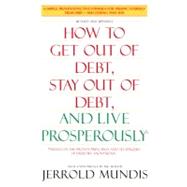
Note: Supplemental materials are not guaranteed with Rental or Used book purchases.
Purchase Benefits
| Preface | 1 | (8) | |||
|
|||||
|
|||||
|
|||||
|
|||||
|
|||||
| Part I The Debt Spiral | |||||
|
9 | (10) | |||
|
|||||
|
|||||
|
|||||
|
|||||
|
|||||
|
19 | (5) | |||
|
|||||
|
|||||
|
|||||
|
24 | (12) | |||
|
|||||
|
|||||
|
|||||
|
|||||
|
|||||
|
|||||
|
|||||
|
|||||
|
|||||
|
|||||
|
|||||
|
|||||
|
|||||
|
|||||
|
|||||
|
|||||
|
|||||
|
|||||
|
|||||
|
|||||
|
36 | (23) | |||
|
|||||
|
|||||
|
|||||
|
|||||
|
|||||
|
|||||
|
|||||
|
|||||
|
|||||
|
|||||
|
|||||
|
|||||
|
|||||
|
|||||
|
|||||
|
|||||
| Part II Stopping the Debt Spiral Cold | |||||
|
59 | (12) | |||
|
|||||
|
|||||
|
|||||
|
|||||
|
|||||
|
|||||
|
|||||
|
|||||
|
|||||
|
|||||
|
71 | (14) | |||
|
|||||
|
|||||
|
|||||
|
|||||
|
|||||
|
85 | (8) | |||
|
|||||
|
|||||
|
93 | (15) | |||
|
|||||
|
|||||
|
|||||
|
|||||
|
|||||
|
|||||
|
|||||
|
|||||
|
108 | (20) | |||
|
|||||
|
|||||
|
|||||
|
|||||
|
|||||
|
|||||
|
|||||
|
128 | (7) | |||
|
|||||
|
|||||
|
|||||
|
135 | (32) | |||
|
|||||
|
|||||
|
|||||
|
|||||
|
|||||
|
|||||
|
|||||
|
|||||
|
|||||
|
|||||
|
|||||
|
|||||
|
|||||
|
|||||
|
167 | (10) | |||
|
|||||
|
|||||
|
|||||
|
|||||
|
|||||
| Part III Turning it Around | |||||
|
177 | (12) | |||
|
|||||
|
|||||
|
|||||
|
|||||
|
|||||
|
|||||
|
|||||
|
189 | (5) | |||
|
|||||
|
|||||
|
|||||
|
194 | (17) | |||
|
|||||
|
|||||
|
|||||
|
|||||
| Part IV Freedom, Prosperity, & Abundance | |||||
|
211 | (11) | |||
|
|||||
|
|||||
|
|||||
|
|||||
|
|||||
|
|||||
|
|||||
|
|||||
|
222 | (14) | |||
|
|||||
|
|||||
|
|||||
|
|||||
|
|||||
|
|||||
|
|||||
|
|||||
|
|||||
|
|||||
|
236 | (15) | |||
|
|||||
|
|||||
|
|||||
|
|||||
|
|||||
|
251 | (12) | |||
|
|||||
|
|||||
|
|||||
|
|||||
|
|||||
|
|||||
|
263 | (18) | |||
|
|||||
|
|||||
|
|||||
|
|||||
|
|||||
|
|||||
|
281 | (3) | |||
|
|||||
|
284 | (4) | |||
|
|||||
|
|||||
|
|||||
|
|||||
|
|||||
|
288 | (6) | |||
|
|||||
|
|||||
|
|||||
|
|||||
|
294 | (7) | |||
|
|||||
|
|||||
|
|||||
|
|||||
|
|||||
|
|||||
|
|||||
| A Closing Note | 301 |
The New copy of this book will include any supplemental materials advertised. Please check the title of the book to determine if it should include any access cards, study guides, lab manuals, CDs, etc.
The Used, Rental and eBook copies of this book are not guaranteed to include any supplemental materials. Typically, only the book itself is included. This is true even if the title states it includes any access cards, study guides, lab manuals, CDs, etc.
Excerpted from How to Get Out of Debt, Stay Out of Debt and Live Prosperously: (Based on the Proven Principles and Techniques of Debtors Anonymous) by Jerrold J. Mundis
All rights reserved by the original copyright owners. Excerpts are provided for display purposes only and may not be reproduced, reprinted or distributed without the written permission of the publisher.